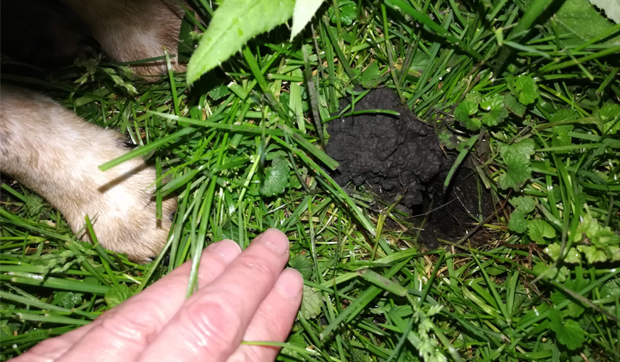After May’s heavy rains, dozens of mystery burrows erupted in a Wheaton backyard. The small-ish holes were about the size of a nickel. Adult fingers and puppy paws are included for scale.
Good Natured: Mystery Burrows
June 12, 2020
So today I’m wondering, how many of you passed at least part of our corona quarantine poring over jigsaw puzzles? I have several friends who did, and most all reported with a note of triumph that they finished their (fill in the blank)-piece puzzle in (a corresponding number of) days or weeks. (Well, except for that one person who attempted a 1,000-piece murder mystery puzzle that had no picture to go by. That puzzle is still arrayed on a card table with only the border complete. And yes, that person was me.)
At any rate, finding pieces that go together, whether in jigsaw puzzles or in life, is tremendously satisfying. That little snap, that snug, precise fit-they combine to create a clearer picture, and a feeling of accomplishment.
It follows, then, that when pieces don’t fit, a feeling of disorder ensues. You know what I’m talking about… You try to make the piece work. You push, you shove, you thump with your fist but, doggone, it’s just not right.
That sense of discord is exactly what I was feeling for the better part of a recent week. But instead of a jigsaw, it grew from a puzzle of a different sort-one that turned out to be 17 years in the making.
I suppose I should back up a few weeks, to May. Our rainiest, soggiest May ever.
During a brief dry spell, I headed over to Wheaton to take care of some yardwork at my mom’s house. As I pushed the mower around the backyard, I kept a careful eye out for morels. You never know, I thought as I reflected on my previous week’s find, if lightning can strike twice in one spot, maybe mushrooms can too.
Well, the ersatz mushroom hunt was a bust, but I didn’t mind. I’d found something way more interesting.
Distributed around the backyard were dozens of holes surrounded by tiny chimneys made of mud. Most were about as big around as a nickel, and some were filled with water. Curious, I stuck my finger down one and realized I couldn’t touch the bottom. Hmm. A puzzle!
Before we go about putting all the pieces together, here’s a little more of the picture: Twenty years ago or so, my parents’ backyard neighbors moved their house forward about 50 feet on their large lot. That move triggered a big change in the way water behaves on the block, and led to my folks getting water in their basement and an overall squishiness in the yard following big rains and snowmelts.
A French drain system and upgraded sump pumps helped with the basement issues, but to this day the backyard gets very marshy when we have a lot of rain. And, speaking of marshes, my mom’s house is about a mile from the Wheaton Park District’s Lincoln Marsh.
Why is this important? Well, as I was trimming some dead branches, I was musing over those holes with the mud chimneys and who or what might have made them. And the first critters that came to mind were burrowing crayfish.
You might recognize crayfish as the freshwater version of a lobster. Smaller by a great degree, they nonetheless are equipped with the same number of legs (10) and an impressive pair of chelae, or pincer-like claws.
While most crayfish live in water, a few species are more terrestrial, digging burrows that extend down to the water table. As I pulled sow thistles from the groundcover bordering Mom’s yard, I mused on the three species of burrowing crayfish we have in this area, and the likelihood of a slew of small, young ones traveling through groundwater channels from Lincoln Marsh to my mom’s very landlocked yard.
That night, around midnight, I headed out to the yard to see if maybe I could find some crayfish foraging in the damp grass. I found some muddy haze around some of the burrows, as if a creature had emerged, but when I shined my flashlight down into the holes as well as across the yard I saw nothing, save for a few small moths attracted to the light.
The following week I kicked those crayfish thoughts around quite a bit, researching movement in terrestrial species, and still nothing came to light-flash or otherwise. There was something about that puzzle piece that just didn’t fit.
The burrowing crayfish holes I’ve seen in the past tended to be larger than the ones at my mom’s-a half-dollar or so in diameter as opposed to nickel sized. The chimneys were taller too, which would indicate that their burrows go deeper than what I was seeing. Still, if the crayfish were young enough…
Determined to solve the puzzle once and for all, I went back the following day and got a shovel from the shed. I sunk the blade into the ground, turned the soil and found, again, nothing, save for a few earthworms.
Remember how back at the start of the column I said some puzzles take days or weeks to solve? This is one of them! We’re out of space for this week. But be sure to tune in next week, when we’ll look high and low for the missing piece to this fun nature puzzle.
Pam Otto is the outreach ambassador for the St. Charles Park District. She can be reached at 630-513-4346 or potto@stcparks.org.

